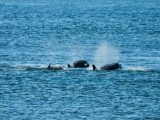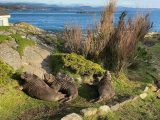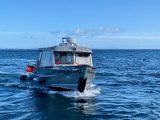Wind: yesterday 0-36 knots from W, E, S, W throughout the day, today 9-40 knots from W
Sea State: yesterday rippled changing in late afternoon onwards to chop up to 1 m, today calm in early morning then up to 1 m chop for rest of the day
Visibility: both days 10-15 NM
Sky: both days overcast
Temperature: yesterday 5-9 °C, today 7-10 °C
Atmospheric CO2: 413.72 ppm (recorded by NOAA at Mauna Loa Observatory, Hawaii)
The ecological highlights of the past two days were a bald eagle eating a bird and as usual the very entertaining elephant seals.
A new female elephant seal arrived on the main island this morning. She is tagged T563 on tags on each of her tail flippers. I contacted elephant seal researchers to check her history. She was tagged as a pup in the birthing season of 2010-2011, on the Farallon Islands, off the coast of San Francisco. That makes her just over nine years old. She hasn’t been seen by those researchers since. Last year, Ecoguardian Laas spotted her for the first time at Race Rocks on March 21. This morning, the alpha male was attempting to mate with her. Now she is hunkered down by the flagpole, shielded from the strong west wind. The adult males were bellowing at each other for most of the day. The beta male has an advantage of a high lookout point, on the helicopter pad. He has been up there since January without leaving. I am not sure he knows how to get down, as I have seen him attempt a few times before turning around. He must be getting hungry.
The oldest of the two female pups might have gone for a swim yesterday. I saw her with wet fur climbing up the rocks from the east bay.
The youngest female pup and oldest and only male pup have been hanging together, vocalizing with each other and appearing to play fight.
In between watching nature neatos, I did some maintenance around the island. I used a new two metre pressure washer wand to get the algae off the north side of the boat house, tank shed and Race Rocks sign. I hope to clean off the rest of the buildings over the next few weeks, now that the desalinator is pumping lots of freshwater. I also fixed the door on the freshwater shed with a new hasp and a piece of wood to stop the door from blowing inwards.
No boats or visitors were in the ecological reserve over the past two days.
Here are some photos from the past two days:
-

-
After this eagle flew around the island with a bird in its talons, it landed on the high point of rocks by camera 5. The unlucky bird appeared to be a pigeon guillemot.
-

-
The eagle spent a while plucking the feathers to get at the meat.
-

-
I used camera 5 to get a better look at the eagle eating its meal. Look at all the feathers the eagle plucked.
-

-
An extreme closeup of the eagle eating the bird.
-
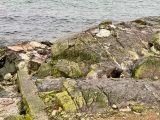
-
Yesterday, the oldest of the two female pups makes her way up from the water of the east bay. She chose a difficult route to ascend.
-

-
I took this photo yesterday through the spotting scope in the lantern room of the lighthouse. The grey elephant seal near the middle is the female that arrived on the main island this morning. The brown figures are sea lions.
-

-
The sun is rising behind the female, pups and alpha male elephant seal.
-

-
The tail flipper tag on the recently arrived female. T563 has almost worn off since she was tagged as a pup in the winter of 2010-2011. That makes her nine years old.
-
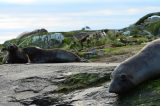
-
The alpha male and the oldest and youngest pups were nearby to check out the female.
-

-
Cute! The oldest (left) and youngest (right) elephant seal pups are getting along well.
-

-
The adult male on the helicopter pad appeared to be taunting the alpha male, who couldn’t get up the fortification.
-

-
The forgotten middle child is by herself behind the house, near the compost bins. She appears to be showing off her fresh new coat, after moulting the dark fur on her chest.
-

-
There have been lots of pigeon guillemots in the morning by Middle Channel, the rocks by the jetty and near the east bay.
-

-
Grape hyacinths are popping up around the rocks and ledges in the centre of the island. Another remnant of lighthouse keepers past.









